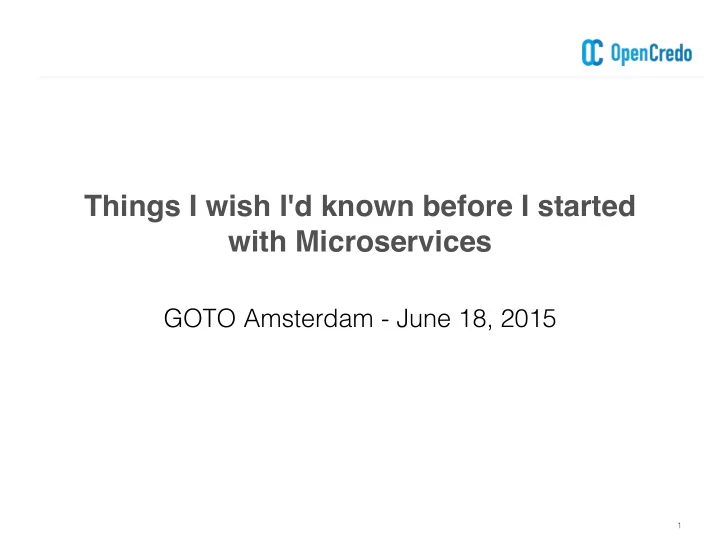

Things I wish I'd known before I started with Microservices GOTO Amsterdam - June 18, 2015 1
Who are we? Steve Judd - Lead Consultant Tareq Abedrabbo - CTO OpenCredo - an Open Source software consultancy 2
Agenda Things I wish I'd known before I started with Microservices What? Why? How? 3
What’s the story morning glory? “Gotta have a definition, right?” 4
WHAT • It is an architecture • Independently deployable software components (services) • Stateless, loosely coupled, resilient • Communicate via explicit, published APIs • Each service fulfils a single business capability • Automated testing and deployment is essential • It’s a choice • It’s not the only one • Commitment is key 5
So, what’s the big deal? Go on, convince me…. 6
WHY • Encourages: ★ loose-coupling ★ separation of concerns ★ single responsibility principle ★ domain-driven design • Good fit with Agile development practices • Well-suited to a containerised infrastructure 7
Monoliths: friend or foe? And are Microservices really the new black? 8
WHY Microservices Monoliths • Flexible scaling options • Familiar & well- • Enables independence in understood development and • Easy to develop, build & deployment deploy • Reduces technology lock-in • Consequences of • Better fault tolerance changing domain design • Build/deploy/execution are localised infrastructure is complex • Limited scaling choices (automation a must) • Long-term commitment to • Getting the domain (service) boundaries right can be tech stack (technology difficult lock-in) 9
WHY Microservices Monoliths • Flexible scaling options • Familiar & well- • Enables independence in understood development and • Easy to develop, build & deployment deploy • Reduces technology lock-in • Consequences of • Better fault tolerance changing domain design • Build/deploy/execution are localised infrastructure is complex • Limited scaling choices (automation a must) • Long-term commitment to • Getting the domain (service) boundaries right can be tech stack (technology difficult lock-in) 10
WHY Microservices Monoliths • Flexible scaling options • Familiar & well- • Enables independence in understood development and • Easy to develop, build & deployment deploy • Reduces technology lock-in • Consequences of • Better fault tolerance changing domain design • Build/deploy/execution are localised infrastructure is complex • Limited scaling choices (automation a must) • Long-term commitment to • Getting the domain (service) boundaries right can be tech stack (technology difficult lock-in) 11
The importance of contracts “Until the contract is agreed, nothing is real” 12
HOW • Design your API contracts first • Communicate them well • Use tools to document them, e.g • apidocjs (http://apidocjs.com/) • swagger (http://swagger.io) • spring-restdocs (https://github.com/spring-projects/spring-restdocs) • Be mindful of the impact of changing an API 13
HOW • If you don’t specify your contract, you end up with an implicit one anyway • Use the power of resources (HTTP and REST) ✤ Links and locations ✤ Uniform interface and status codes ✤ Representations 14
Does size matter? Provide as many APIs and Services as you need but no more 15
HOW • Size - what really matters is quality not quantity • Services should be decoupled conceptually so that they can evolve independently • Services should be decoupled technically so that they can be managed independently • What do I do, practically ? • Co-locate services, but avoid implicit dependancies though shared common objects • Separate services but avoid sharing (domain) libraries 16
HOW • Don’t stress about how many APIs or Services • Do stress about designing an appropriate domain models for your services • Don’t separate your services based on technical boundaries • Do separate your services based on self-contained functions 17
Separating the men from the boys What does a good microservice look like? 18
HOW • Logging & monitoring ✤ Centralised collection ✤ Many more moving parts • How the services are managed • External configuration • Handling failure • Inter-process communication ✤ Message serialisation/deserialisation ✤ Network overhead 19
And finally…. 20
Final takeaways 1. Specify your contracts first AND communicate them 2. Design for scale : infrastructure, processes, services 3. You’ll need to pay the Distributed Service Tax 4. Everything is a Service (aka eat your own dogfood) 5. Invest in tooling and automation 21
Thank you, any questions? http://www.opencredo.com/blog @OpenCredo @cyberbliss @tareq_abedrabbo
Recommend
More recommend